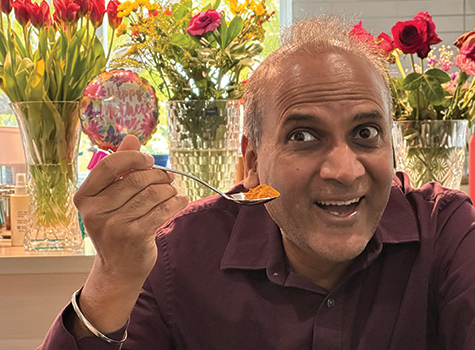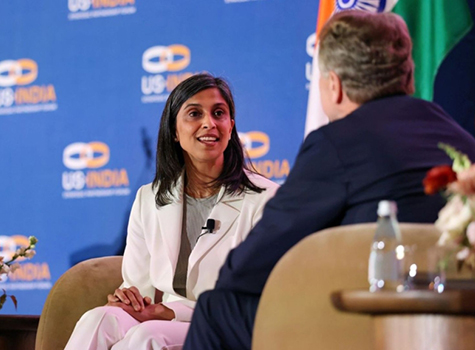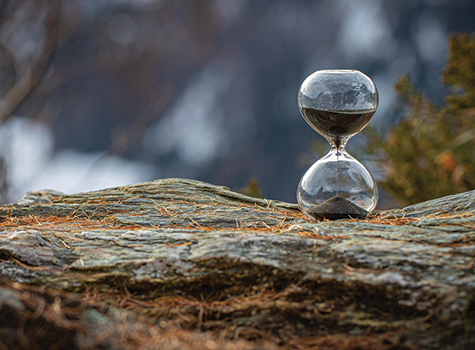
There is no doubt that Indian culture is great with rich practices and traditions grounded in science. That is unlike American culture, which is great with rich practices and traditions… but the “science” part kind of depends on who you talk to!
For example, turmeric originated in India. Its use dates back over 4,000 years to the Vedic culture in India. In this ancient culture, turmeric was utilized for its medicinal properties, as a culinary spice, and in religious ceremonies. If you wanted to escape a wedding ceremony, you’d quickly throw it in the bride’s eyes and run!
Turmeric has become mainstream in the US – you can buy turmeric capsules mixed with black pepper at Whole Foods and Costco. However, turmeric has been a topic of controversy — not for its health benefits but for its monetization benefits. In 1995, researchers from the University of Mississippi Medical Center were granted a U.S. patent for the use of turmeric in wound healing. This patent was based on the use of turmeric powder for promoting healing of wounds which is a traditional practice in India.
The granting of this patent sparked outrage in India, where turmeric has been used for centuries for medicinal properties. The Council of Scientific and Industrial Research (CSIR), a research and development organization in India, challenged the patent arguing that the use of turmeric for wound healing was not a novel invention but part of traditional Indian knowledge. They provided evidence from ancient Sanskrit texts and modern scientific publications to support their claim. They even found a white guy to repeat it all so that Americans would listen to them!
In 1997, the United States Patent and Trademark Office (USPTO) upheld the challenge and revoked the patent, agreeing that the claimed use of turmeric was indeed part of the prior invention and therefore not patentable. There is no doubt that the original claim for patent in the use of turmeric was motivated by monetary gains. That, or the guys at Whole Foods just don’t like to share curry recipes.
This case was one of the first major victories against biopiracy, highlighting the importance of protecting traditional knowledge and ensuring that it is not exploited by entities seeking to gain exclusive rights over age-old practices. Luckily, turmeric grows in tropical climates, so India remains the largest producer and exporter of turmeric today, accounting for about 80% of the world’s production. The other 20% are college kids who secretly think they’re growing weed but end up being disappointed.
Like turmeric, Ashwagandha has its origins in India. In Sanskrit, “ashwagandha” means “smell of the horse,” which refers to the distinct smell of the root and the belief that consuming it imparts the strength and vitality of a horse. This is unlike the herbs I keep getting spam emails about, which promise I’ll get a different feature that’s also “like a horse.”
Ashwagandha has been used for thousands of years in Ayurvedic medicine, one of the world’s oldest holistic healing systems. Traditionally, Ashwagandha has been used to enhance vitality, longevity, and overall well-being. It is used to treat a variety of conditions, such as stress, anxiety, fatigue, and inflammation. So basically, all the problems that come from eating foods cooked with too much turmeric.
I researched to see if there were any patents on Ashwagandha. There are none as of now. I am sure the reversal by USPTO on the turmeric patent deterred any attempt by private entities to claim that they invented its use to cure stress and improve vitality. While it is interesting to see Ashwagandha being mentioned on television ads that certain medicines have it as an ingredient, it is amusing to see the announcer completely mangling its pronunciation… usually by adding a few extra syllables, then giving up and just calling it “the secret Indian stuff.”
Unlike turmeric, Ashwagandha has not become mainstream in the US yet. Even though no company or entity has a patent on turmeric or Ashwagandha, American companies profit more from their sale. It is comforting to see India at least getting some benefits out of its inventions. They are still waiting for some residuals from that whole “Kama Sutra” thing.
Overall, we have not done a very good job in monetizing our inventions. Our ancestors came up with all the postures of Yoga. Our ancestors knew how to bend their ankles and arms. With Yoga, we helped improve the health of millions of people. But we made no money on it.
We could have, but we wrapped our legs around our necks, and our wallet was in our back pocket… which would be completely out of reach.
On the other hand, Americans have a great job in profiting from our inventions. While we were focused on perfecting the postures, Americans looked at yoga and asked, what’s missing? Yoga pants. They came up with $100 Lulu Lemon mats. They turned yoga into a billion-dollar industry. They put yoga on Vogue’s cover. Indians’ perspective was, look what amazing things we can do. Americans’ perspective was, pay me $5 for a magazine to see what the hot models can do… which, to be fair, is also the American perspective for hamburgers, politics, and basically everything.
Like yoga, we invented the game of chess. The game originated in ancient India as Chaturanga before spreading to other parts of the world. It is one of the oldest and most popular board games in existence. It is played and enjoyed by millions of people worldwide; mostly by nerds who don’t like sports — but it still counts!
Yoga, like chess, has something else in common. Zero. India made zero dollars on yoga or chess, two of its biggest inventions. Heck, India made zero dollars on Zero itself which was invented by Indian mathematicians like Brahmagupta and Aryabhata around the 5th to 7th centuries AD.
We came up with Kama Sutra. We literally created a guide to sexual positions. You know what Americans call it? Porn. They took the concept to a whole new level and made billions out of the porn industry. And you know what we did? Nothing. We made no money. We were still not satisfied so we went one step further. We banned it everywhere and wiped the evidence out of history.
India is now poised to be ranked third largest economy by 2027 after the US and China. US firms have 1.5 million staff in India, more than any other foreign country in the world. As India’s economic clout continues to grow, I am confident that its contribution to the world over the millenniums in science, arts, medicine, and other fields will get the recognition it has long deserved … and once it does, that’s when India will let the world see the uncensored version of the Kama Sutra with all the good stuff!
Raajeev Aggerwhil is a Los Angeles-based comedian. Follow him on Instagram @raajeevcomedy or @IndianComedyCouple. To see his videos on YouTube: youtube.com/c/raajeevcomedy.



